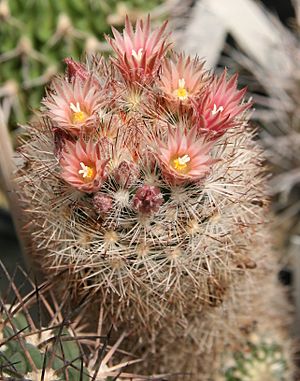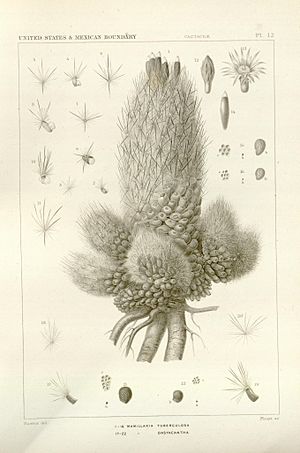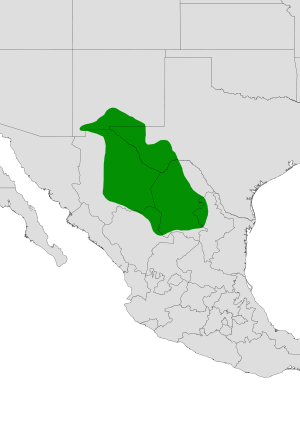Escobaria tuberculosa facts for kids
Quick facts for kids Escobaria tuberculosa |
|
|---|---|
 |
|
| In bloom | |
 |
|
| Botanical illustration | |
| Conservation status | |
| Scientific classification | |
| Genus: |
Escobaria
|
| Species: |
tuberculosa
|
 |
|
| Range | |
The corncob cactus, also known as Escobaria tuberculosa, is a unique type of cactus. It belongs to the Cactaceae family, which includes all cacti. This interesting plant is found in the south-central parts of the United States and northern Mexico.
It gets its common name, "corncob cactus," because its shape and texture can look a bit like a corncob. Unlike many plants, this cactus has a special preference for where it grows. You'll usually find it living on igneous rocks, which are rocks formed from cooled lava or magma.
Contents
What Does It Look Like?
The corncob cactus is a small, round, or cylinder-shaped plant. It usually grows alone, but sometimes you might see a few stems clumped together. Each stem can be about 2 to 10 inches (5 to 25 cm) tall and 1 to 3 inches (2.5 to 7.5 cm) wide.
Spines and Tubercles
Like most cacti, the corncob cactus has spines. These aren't just for show; they help protect the plant from animals and also collect dew, which is important for survival in dry places. The spines grow from small bumps on the cactus called tubercles. These tubercles are what give the cactus its bumpy, corncob-like appearance.
Beautiful Flowers
When the corncob cactus blooms, it produces pretty flowers. These flowers are usually pink, purple, or sometimes even white. They often appear near the top of the cactus. After the flowers, the cactus grows small, red fruits. These fruits are often eaten by birds and other desert animals, which helps spread the cactus seeds.
Where Does It Live?
The corncob cactus is native to the Chihuahuan Desert region. This desert stretches across parts of Texas and New Mexico in the United States, and several states in northern Mexico. It's a hot and dry place, but the corncob cactus is perfectly adapted to survive there.
Surviving in the Desert
Cacti are amazing at living in dry environments. The corncob cactus stores water in its stem, allowing it to last through long periods without rain. Its tough outer skin helps prevent water from evaporating. Growing on igneous rocks might also help it by providing good drainage and sometimes protecting its roots from extreme heat.
Conservation Status
The corncob cactus is currently listed as "Least Concern" by the IUCN. This means that it is not considered to be in danger of extinction right now. However, it's always important to protect natural habitats to ensure plants like the corncob cactus can continue to thrive.
See also
 In Spanish: Biznaga rómbica para niños
In Spanish: Biznaga rómbica para niños


